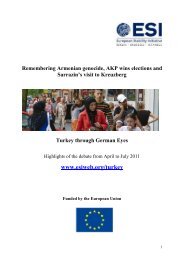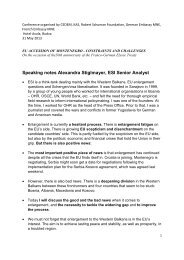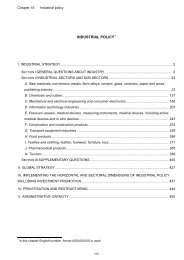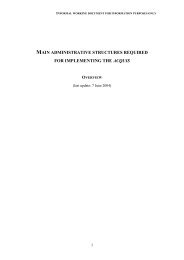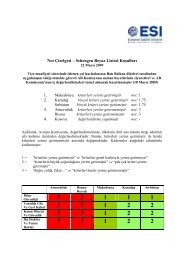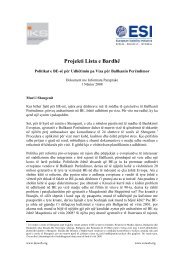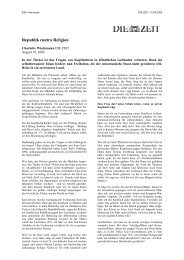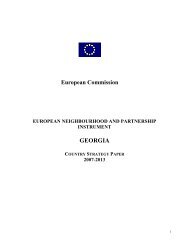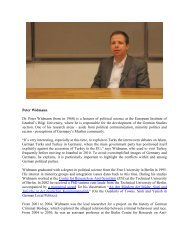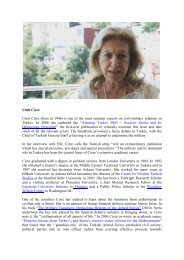to view this document - European Stability Initiative - ESI
to view this document - European Stability Initiative - ESI
to view this document - European Stability Initiative - ESI
Create successful ePaper yourself
Turn your PDF publications into a flip-book with our unique Google optimized e-Paper software.
Building Capacity:<br />
Applying EU Experience <strong>to</strong> the Western Balkans<br />
Presented at Catching up? The Western Balkans and the New Europe,<br />
Oslo, May 12-15, 2003<br />
John Bradley<br />
There is an old joke <strong>to</strong>ld about economists. It is often said that they are people who<br />
worry about whether things that are known <strong>to</strong> work in practice will also work in<br />
theory!<br />
But there is a sting in the tail of <strong>this</strong> joke. Namely, that new policy initiatives – such as<br />
extending a type of EU Structural Fund investment aid <strong>to</strong> the Western Balkans - often need<br />
compelling intellectual support in addition <strong>to</strong> demonstrable practical need. Where ideology<br />
and logical arguments reinforce a case based on obvious need, vigorous and effective action<br />
often results. But when need and ideology clash, ideology often wins the day.<br />
Let me illustrate <strong>this</strong> by referring <strong>to</strong> and earlier presentation in our conference. Three rather<br />
striking points were made concerning the development of the Western Balkans region:<br />
(1) Any outside financial support <strong>to</strong> the region should be transitional;<br />
(2) The region does not consist of “developing” countries; and<br />
(3) The region was wealthy before, and should be capable of regaining the prosperity that<br />
it once enjoyed.<br />
Behind <strong>this</strong> cautious attitude presumably lies a reluctance <strong>to</strong> be seen <strong>to</strong> promote what was<br />
earlier referred <strong>to</strong> as “aid addicted societies”, and what we economists refer <strong>to</strong> as a<br />
Mezzogiorno problem, after the regions of Southern Italy which have been in receipt of largescale<br />
aid since the early 1950s, and which has stubbornly refused <strong>to</strong> develop and catch up<br />
with the more prosperous Northern Italian regions.<br />
The term “cohesion” first came in<strong>to</strong> use in the late 1980s at the time major reforms and<br />
expansions of EU regional aid were being carried out. As set out in Article 130a of the<br />
Treaty on <strong>European</strong> Union, there is an explicit aim <strong>to</strong> promote “harmonious development”<br />
with a specific geographical dimension: “reducing disparities between the levels of<br />
development of the various regions and the backwardness of the least favoured regions”.<br />
Thus, there is an explicit recognition that wide disparities are in<strong>to</strong>lerable in any community, if<br />
that term has any real meaning.<br />
Orthodox (or neo-classical) theory takes the <strong>view</strong> that all one has <strong>to</strong> do <strong>to</strong> promote cohesion<br />
between the regions of any state or between grouping of states is <strong>to</strong> put in place policies that<br />
facilitate the free movement of goods and the fac<strong>to</strong>rs of production (i.e., labour and capital).<br />
Newer theories of growth and development have served <strong>to</strong> focus attention on the importance<br />
of such fac<strong>to</strong>rs as the initial level of regional physical infrastructure, local levels of human<br />
1
capital, the fact that regions that start off at a structural disadvantage may never converge in<br />
any reasonable time period.<br />
The political problem is that the benefits of EU Structural Fund-type investment aid are by no<br />
means accepted universally, particularly by the major donor states: Germany, the UK and the<br />
Netherlands. In the empirical policy literature, the debate rages, and both sides point <strong>to</strong><br />
studies that show that such policies in the past have had a wide spectrum of effects ranging<br />
from negative <strong>to</strong> positive. For example, recent evaluations by the Dutch Planning Bureau –<br />
the influential CPB – suggested that such aid was useless in promoting growth other than in a<br />
context of complete economic openness <strong>to</strong> the forces of globalization.<br />
So, even if there were a political willingness <strong>to</strong> do so, the empirical economic case for<br />
extending EU investment aid <strong>to</strong> the Western Balkan region is by no means self evident. A<br />
compelling case needs <strong>to</strong> be built.<br />
In an earlier revealing interchange at our conference, we learned how the <strong>European</strong><br />
Commission reacted <strong>to</strong> a Romanian request for an easement of visa restrictions. It appears<br />
that the Romanians were <strong>to</strong>ld <strong>to</strong> go away and make the case! The same applies <strong>to</strong> the<br />
extension of Structural Fund-type assistance <strong>to</strong> the West Balkan region. The West Balkan<br />
states will have <strong>to</strong> make a compelling case, particularly in an internal political context that is<br />
by no means favourable <strong>to</strong> success.<br />
In my short presentation I want <strong>to</strong> share with you some insights from the EU experience with<br />
Structural Fund aid since 1989, and how <strong>this</strong> is being extended <strong>to</strong> the acceding states from<br />
2004, after an extended prior period of transitional aid during the 1990s. The <strong>European</strong><br />
<strong>Stability</strong> <strong>Initiative</strong> (<strong>ESI</strong>) and Gerald Knaus in particular - has made an eloquent practical case<br />
for <strong>this</strong> kind of investment aid system <strong>to</strong> be extended <strong>to</strong> the Western Balkans. Their policy<br />
prescription – as laid out in the paper entitled The Road <strong>to</strong> Thessaloniki in March <strong>this</strong> year<br />
(which was stated earlier in November, 2002 in Assistance, cohesion and the new boundaries<br />
of Europe), is as follows;<br />
(1) A pledge <strong>to</strong> make cohesion an explicit EU objective in the Western Balkans;<br />
(2) A commitment <strong>to</strong> applying lessons from cohesion policy in the EU and the acceding<br />
countries <strong>to</strong> the Western Balkans;<br />
(3) A commitment <strong>to</strong> sustaining assistance levels so that the gap between the present<br />
candidate countries, such as Bulgaria and Romania, and the countries of the Western<br />
Balkans does not wider further.<br />
The <strong>ESI</strong> case is a compelling on the grounds of trans-<strong>European</strong> equity. My contribution<br />
will be <strong>to</strong> write a footnote <strong>to</strong> bolster that with additional arguments on the basis of<br />
efficiency, and I hope that the overall case will be persuasive in the corridors of<br />
Brussels!<br />
First, I will briefly describe the type of planning, moni<strong>to</strong>ring and evaluation systems that lie<br />
behind large-scale Structural Fund programmes, and <strong>this</strong> will beg the question as <strong>to</strong> whether<br />
the economies of the Western Balkan region are currently in a position <strong>to</strong> replicate such<br />
systems. For those interested in more detail, I have a separate detailed paper that I can make<br />
available.<br />
2
Then I will comment on some features of the West Balkan economies that appear <strong>to</strong><br />
stand in the way of successful Structural Fund-type programmes. These problems need<br />
<strong>to</strong> addressed directly and honestly.<br />
Finally, I will make some suggestions on what form an EU aid package might take and how<br />
the region itself might create conditions that might call forth a favourable response from<br />
Brussels.<br />
Living with Structural Funds:<br />
EU regional investment aid was expanded greatly in the late 1980s for two main reasons;<br />
(1) Successive enlargements had brought in a group of poorer countries (Ireland, Greece,<br />
Portugal, <strong>to</strong> a lesser extent Spain), and there was a risk of a two-tier Europe: rich and<br />
poor;<br />
(2) In the Single <strong>European</strong> Market initiative of 1992, there was a serious risk that the rich<br />
would become richer, and the poor would become poorer;<br />
Given the very small size of the overall EU budget (under 1.5% of EU GDP compared with<br />
40-50% for national budgets), the regional investment aid was focused on the poorest states<br />
(Greece, Ireland, Portugal) and the poor regions of states (southern Italy, southern Spain, and<br />
after German unification, the East German Lander). A special category of under<br />
development was defined: Objective 1 states are those whose general economic performance<br />
lagged behind the EU norm. Other sub-categories have also been defined: regions suffering<br />
from de-industrialization, regions suffering from serious youth unemployment, etc.<br />
What is special about the Structural Fund-type policies is their goals, i.e., <strong>to</strong> design and<br />
implement policies with the explicit aim of transforming the underlying structure of the<br />
beneficiary economies in order <strong>to</strong> prepare them for exposure <strong>to</strong> the competitive forces<br />
being unleashed by the Single Market. This was, in effect, “economy-building”, the<br />
economic equivalent of political “nation building”.<br />
These policies moved far beyond a conventional stabilization role, being directed at the<br />
promotion of structural change, faster long-term growth, and real convergence through<br />
mainly supply-side processes. They are intended <strong>to</strong> leave enduring impacts in terms of<br />
enhanced economic performance, even after the funding is wound down and<br />
terminated.<br />
There are three main channels through which the development-enhancing effects of EU<br />
Structural Fund aid operate. These investment programmes:<br />
1. Improve the physical infrastructure of the economy (roads, rail, air, sea, and electronic<br />
access, etc);<br />
2. Raise the level of human capital (through enhancing the skills and education of the<br />
labour force); and<br />
3. Directly assist private sec<strong>to</strong>r performance by subsidizing productivity-enhancing<br />
investment.<br />
3
How relevant are these policies <strong>to</strong> the West Balkan states?<br />
The first phase of the transition of the former command economies of Central and South-<br />
Eastern Europe involved considerable disorganization and a very basic overhauling of<br />
industrial and institutional capacity. Socio-economic mechanisms operating during <strong>this</strong><br />
phase entailed the creation of market-based institutional structures accompanied by<br />
substantial reallocation of labour between the public and private sec<strong>to</strong>rs, as well as between<br />
manufacturing and market services.<br />
The initial impacts of restructuring generated the well-known U-shaped pattern for income<br />
and employment: a sharp decline in activity, a bot<strong>to</strong>ming out, followed by recovery. Most<br />
CEE economies have clawed their way back <strong>to</strong> a level of performance that at least equals that<br />
experienced prior <strong>to</strong> the liberalization of the late 1980s. Many have moved far beyond that<br />
baseline level. One country – Slovenia – has performed so well that it is about <strong>to</strong> move<br />
beyond the level of relative GDP per head that serves <strong>to</strong> define Objective 1 status: namely,<br />
75% of the EU average.<br />
This first phase of transition is by no means complete in the Western Balkan region. Gerald<br />
Knaus’s presentation earlier at our conference, in combination with a series of detailed <strong>ESI</strong><br />
papers – mainly from the Lessons Learned and Analysis Unit – illustrate just how far from<br />
completion <strong>this</strong> first phase is.<br />
However, the processes that characterize the early years of transition in the Western Balkans<br />
should not be taken as the pattern of behaviour for the future. The second phase of transition<br />
is more likely <strong>to</strong> resemble the path followed in recent decades by EU countries like Greece,<br />
Ireland and Portugal, where the driving forces behind cohesion (or catch-up) include:<br />
1. Progressive trade integration with the EU;<br />
2. Foreign direct investment inflows;<br />
3. Technology transfer; and<br />
4. EU-aided investment programmes, mainly for the support of infrastructural and<br />
human-capital development.<br />
What does the EU look for from any Structural Fund-driven development strategy? Briefly,<br />
it should provide a coherent and comprehensive set of policies for economic and social<br />
development for the foreseeable future, and it must be consistent with the availability of<br />
resources and its various parts must be well integrated.<br />
More formally, it must have four crucial elements.<br />
First, it must set explicit targets. Prosperous developed countries can enjoy the luxury of<br />
setting a diverse range of socio-economic targets, since they tend <strong>to</strong> have adequate<br />
resources. Developing countries, on the other hand, need <strong>to</strong> focus on the over-riding<br />
target of accelerating growth of income per head. Given appropriate care in influencing<br />
income distribution within the country, other desirable socio-economic objectives tend <strong>to</strong><br />
come in<strong>to</strong> line as a direct consequence of income growth (e.g., facilitating improvements in<br />
social conditions in the health and education areas, improved environmental care, etc.).<br />
Second, development strategy must clearly identify constraints. For any poorer country,<br />
constraints are only <strong>to</strong>o plentiful. The country may be located in a peripheral or otherwise<br />
4
unfavourable geographic-economic area, close <strong>to</strong> zones of conflict and of deteriorating<br />
economic performance. In almost all such economies, there is a inadequate set of<br />
institutional structures. The initial level of development is usually low, putting<br />
constraints on the availability of resources (i.e., policy makers face financial constraints<br />
from the balance of payments and in funding public sec<strong>to</strong>r borrowing requirements). It<br />
will probably have an unfavourable initial economic structure, with a very large<br />
agriculture sec<strong>to</strong>r, an unsuitable configuration of industrial sec<strong>to</strong>rs, and a very underdeveloped<br />
market services sec<strong>to</strong>r. The level of human capital as well as the level of<br />
technology tends <strong>to</strong> be low, placing constraints on feasible development strategies. The<br />
need <strong>to</strong> reduce exploitation of non-renewable resources may place further constraints on<br />
growth.<br />
Third, it must identify suitable policy instruments. The availability of suitable social and<br />
economic policy <strong>to</strong>ols is as important for the success of any development plan as the clear<br />
statement of objectives. These usually include increased investment, fiscal incentives aimed<br />
at stimulating the private sec<strong>to</strong>r, and appropriate wage-setting institutions. In particular,<br />
public investment will focus on infrastructure and human capital, with increased investment<br />
in health, education and research, while stressing the need <strong>to</strong> improve telecom and transport<br />
infrastructures as well as building information technology competences. Both foreign and<br />
indigenous firms require incentives, designed <strong>to</strong> make the region more attractive <strong>to</strong> local as<br />
well as inward investment, since <strong>this</strong> latter will be the main facilita<strong>to</strong>r of technology transfer<br />
and the re-orientation of manufacturing <strong>to</strong>wards fast growing export markets. The main<br />
threat <strong>to</strong> restructuring will be unrest in labour markets. An evolution of wage rates that<br />
disregards the need <strong>to</strong> maintain international cost competitiveness will choke off growth.<br />
Consequently, any strategy can benefit from forms of Social Partnership among the three<br />
main institutional players – government, trades unions and employers - aimed at producing an<br />
orderly evolution of wage costs that preserves cost competitiveness.<br />
Finally, it must include a rigorous system of moni<strong>to</strong>ring, evaluation and renewal: Perhaps<br />
definitions of these two terms – moni<strong>to</strong>ring and evaluation - may be useful at <strong>this</strong> stage:<br />
Moni<strong>to</strong>ring: This term is usually used <strong>to</strong> describe the verification of adequate compliance<br />
with policies agreed and codified in the SF treaties and their supporting <strong>document</strong>s, including<br />
financial aspects (was funding spent according <strong>to</strong> the plan?), as well as the collection and<br />
analysis of relevant activity and performance indica<strong>to</strong>rs (length of roads built, numbers of<br />
people trained, etc.).<br />
Evaluation: This term refers <strong>to</strong> the examination of whether the Structural Fund programmes<br />
implemented actually brought about the achievement of the desired goals. This involves the<br />
tracing out and quantification of the chain of causality between structural measures being<br />
applied and the securing of intended objectives. At the most aggregate level, the basic<br />
question is whether or not the Structural Fund programmes taken as a whole promoted<br />
convergence (or cohesion). At a more detailed level, one might seek <strong>to</strong> evaluate how an<br />
individual project (such as the construction of a specific section of new road, the execution of<br />
a specific training scheme, or the provision of a specific aid <strong>to</strong> company export marketing)<br />
increased economic efficiency or addressed market failure.<br />
How has <strong>this</strong> process of Structural Fund aid worked in the EU? Since the late 1980s, there<br />
have been three waves of EU investment aid: 1989-93 (Delors I); 1994-99 (Delors II); and<br />
2000-2006. The acceding states will come in<strong>to</strong> the last programme for the period 2004-2006.<br />
5
The first stage in the SF process involves the preparation of a comprehensive National<br />
Development Plan, setting out:<br />
a) A detailed statement of the socio-economic status quo,<br />
b) A clear diagnosis of the major barriers <strong>to</strong> faster growth and development,<br />
c) An identification of a range of policies that will address these problems,<br />
d) A formal costing of these policies,<br />
e) The execution of an ex ante evaluation of the extent <strong>to</strong> which the NDP will promote<br />
cohesion.<br />
When the details of the NDP have been fully negotiated and agreed with the EC, a formal<br />
CSF (or Community Support Framework) Treaty is drawn up, codifying the arrangements in<br />
a quasi legal way. There are quite complex institutional and organisational requirements <strong>to</strong><br />
<strong>this</strong> process, with important horizontal and vertical elements.<br />
Concerning horizontal aspects, an active system of Social Partnership has always operated in<br />
Ireland. The Social Partnership consists of the main Trade Union organisation (The Irish<br />
Congress of Trades Unions, ICTU), the main employers organisation (the Irish Business and<br />
Employers Confederation, IBEC), the main Farmers organisations, representatives of the<br />
unemployed and socially excluded, and Government (both central and local). This Social<br />
Partnership operates at the very heart of strategic policy-making, and in particular is a vehicle<br />
used <strong>to</strong> negotiate a social pact every three years that covers issues such as wage<br />
determination, the level of social support and many other aspects of government policy.<br />
The Social Partners tend <strong>to</strong> become involved in the moni<strong>to</strong>ring of EU funds mainly through<br />
participation in Steering Committees for the individual Operational Programmes of the<br />
Structural Funds. Social Partners also make important inputs in<strong>to</strong> the formulation and<br />
priorities of the National Development Plans that precede the agreement of the Community<br />
Support Frameworks with the <strong>European</strong> Commission. But they are not normally directly<br />
involved in actual policy decisions. Perhaps <strong>this</strong> situation can be best explained by the fact<br />
that the Irish political system is very “centrist” in structure, with the main parties who enter<br />
governing coalitions grouped around the centre and not strongly divided along a left-right<br />
axis, as in many other EU countries.<br />
Concerning vertical aspects, it must be stressed that regional government in Ireland is very<br />
weak, with little or no policy-making discretion and no fund-raising powers. The small size<br />
of the country (population 3.7 million) also tended <strong>to</strong> encourage continued centralisation in<br />
policy-making, particularly in aspects such as planning the physical infrastructure of the<br />
country in an integrated way, and in ensuring that systems of education and training, as well<br />
as investment incentives, were designed with national interests and standards in mind.<br />
The first two EU Structural Funds (or Community Support Frameworks) covered the periods<br />
1989-93 and 1994-99, and were designed and implemented with a purely national focus. For<br />
the purposes of these CSFs, the whole country was designated as Objective 1, i.e., a lagging<br />
region in need of development and structural adjustment. These CSFs were designed and<br />
administered centrally, by various Government Departments. The nature of moni<strong>to</strong>ring was<br />
determined at the implementation stage. For example, the actual construction of roads were<br />
administered at the level of Local Government, and Local Government had a role in<br />
moni<strong>to</strong>ring progress. Education and training schemes were designed by the responsible<br />
6
Central Government department and administered through a mix of central institutions (such<br />
as a national training agency, FAS) as well as through vocational schools, which came under<br />
the control of Local Government.<br />
In summary, it could be said that the first two Irish CSFs were designed, moni<strong>to</strong>red and<br />
evaluated within a system that had strong horizontal elements, but only limited vertical<br />
elements. Only at the implementation stage did vertical organisational elements come <strong>to</strong> the<br />
fore. The latest CSF – with its greater emphasis on regional issues - has had stronger vertical<br />
elements.<br />
Who administers the moni<strong>to</strong>ring system?<br />
The Managing Authority for each Operational Programme of the CSF is vested in a range of<br />
different bodies. Taking the latest CSF for the period 2000-2006, the Managing Authority for<br />
the overall CSF is the Department of Finance. There are seven Operational Programmes, as<br />
set out below:<br />
1) Economic and Social Infrastructure (Dept of Environment and Local Government)<br />
2) Employment and Human Resources Development (Dept of Enterprise, Trade and<br />
Employment)<br />
3) Productive Investment (Dept of Enterprise, Trade and Employment)<br />
4) Border, Midlands and West Regional Programme (BMW Regional Assembly) 1<br />
5) Southern and Eastern Regional Programme (S&E Regional Assembly)<br />
6) Peace Programme (Special EU Programmes Body) 2<br />
7) Cohesion Fund, devoted <strong>to</strong> physical infrastructure (Department of Finance)<br />
The principal responsibilities of the Managing Authority for each Operational Programme is<br />
as follows:<br />
(a) Chairing and providing the secretariat for the Moni<strong>to</strong>ring Committee.<br />
(b) Assembling statistical and financial information required for moni<strong>to</strong>ring and<br />
supplying <strong>this</strong> information <strong>to</strong> the CSF Evaluation Unit in the Department of Finance.<br />
(c) Drawing up an annual implementation report for approval by the Moni<strong>to</strong>ring<br />
Committee and for submission <strong>to</strong> the <strong>European</strong> Commission.<br />
(d) Submitting payment claims <strong>to</strong> the paying authorities for Structural Funds.<br />
(e) Ensuring that EU funded expenditure is properly accounted for and managed.<br />
(f) Ensuring compliance with EU policies on public procurement, publicity, the<br />
environment and equality.<br />
Each Operational Programme and the CSF as a whole, is supervised by Moni<strong>to</strong>ring<br />
Committees, whose membership has remained fairly stable over all previous CSFs.<br />
Typically, there are representatives from the Managing Authority, the Department of Finance<br />
(which exercises a general supervisory role), other Government Departments and public<br />
bodies involved in implementation of programme measures, representatives from the regional<br />
assemblies and from the Social Partners (all pillars). In addition, there are representatives of<br />
1 For the purposes of CSF 2000-2006, Ireland has been divided in<strong>to</strong> two regions: the Border, Midlands, West<br />
(BMW!) region, designated as Objective 1, and the Southern and Eastern (S&E) region, designated for<br />
transitional aid.<br />
2 The Peace funding is a special issue related <strong>to</strong> the civil conflict in Northern Ireland, which has affected the<br />
border areas of the Republic of Ireland adversely.<br />
7
equal opportunity and environmental interests drawn from relevant Government Departments<br />
or other statu<strong>to</strong>ry bodies.<br />
The Moni<strong>to</strong>ring Committee is responsible for decisions regarding EU co-funded measures in<br />
the Operational Programmes, including decisions on the reallocation of co-funded<br />
expenditure between measures within the Operational Programmes or between Operational<br />
Programme in the case of the overall CSF Moni<strong>to</strong>ring Committee. They are also responsible<br />
for the mid-term re<strong>view</strong> of the Operational Programmes in conjunction with the CSF<br />
Evaluation Unit in the Department of Finance. As regards operating procedures, each<br />
Moni<strong>to</strong>ring Committee is responsible for drawing up its own rules of procedure and agreeing<br />
them with the Managing Authority and the Department of Finance. The Moni<strong>to</strong>ring<br />
Committee is chaired by a representative of the Managing Authority.<br />
Success?<br />
How successful have the CSFs been in promoting faster growth in the EU Objective 1<br />
regions? This is by no means a simple question. To answer it requires one <strong>to</strong> formulate a<br />
hypothetical or counter-factual outcome where Structural Fund aid is absent, and <strong>to</strong> compare<br />
<strong>this</strong> with a situation where aid is available. It also requires one <strong>to</strong> explore the effects of other<br />
changes in the external and policy environment that might also have serves <strong>to</strong> boost growth<br />
(e.g., the Single <strong>European</strong> Market, EMU, CAP reform, the global business cycle, etc.).<br />
To answer these questions requires the assistance of much economic research and the use of<br />
computer models. Cutting through the tedious technical details, research suggests that<br />
the Structural Funds were crucial <strong>to</strong> the enhanced performance of Greece, Ireland and<br />
Portugal. Ireland started at 64% of the EU average living standards in 1988 and by the<br />
end of the 1990s was above 110%. Those figures flatter the Irish performance <strong>to</strong> some<br />
extent, but it represented a massive improvement. We summarize briefly a logical<br />
sequence of interconnected effects that brought about that impressive Irish result.<br />
1. First, the Irish economy in the late 1970s and for the first half of the 1980s was<br />
seriously and massively destabilized – high unemployment, relatively high inflation,<br />
and the public finances almost out of control. Fiscal stabilization measures were<br />
implemented rigorously from the mid-1980s.<br />
2. Second, there were the effects of the Structural Funds. These had demand and supply<br />
effects. As you actually build a road, it injects income and expenditure in<strong>to</strong> your<br />
economy. But the long-lasting benefits of building a road come when it is available <strong>to</strong><br />
connect your cities and <strong>to</strong> transport goods more efficiently in<strong>to</strong> and out of your<br />
economy. So, there was an immediate stimulus <strong>to</strong> demand, and the longer term<br />
benefits came <strong>to</strong>wards the middle of the 1990s.<br />
3. The third event was the beneficial effect of Ireland joining the <strong>European</strong> Monetary<br />
System (or EMS). This was the exchange rate mechanism that was instituted in 1979<br />
and served as a precursor of the 1999 Economic and Monetary Union (or EMU). But<br />
the credibility benefits of Ireland’s membership of the EMS were delayed by about a<br />
decade. The lower Deutsche Mark interest rates did not become available <strong>to</strong> the Irish<br />
economy until the late 1980s when eventually credibility was established.<br />
8
4. The fourth event was the massive inflow of mainly US foreign direct investment,<br />
most of it in high technology areas. This was in part a spin-off benefit of the<br />
Structural Funds, making use of the improved infrastructure and human capital. It<br />
was also due in part <strong>to</strong> Ireland’s access <strong>to</strong> EU markets for exports produced by multinational<br />
companies located and producing in Ireland. Additionally, of course, one of<br />
the long-term elements of Irish policy was a low rate of corporate taxation, designed<br />
<strong>to</strong> attract inward investment.<br />
5. The fifth event, producing a reinforcement of the fiscal stabilization benefits, came as<br />
a result of the Irish government strongly signaling its firm intention <strong>to</strong> join the EMU<br />
from the start-up in January <strong>this</strong> year, even in the absence of our largest trading<br />
partner, the United Kingdom, from EMU membership.<br />
6. Finally, in Ireland there was an evolving social partnership (involving employers<br />
organizations, trades unions and government) that eased the distribution conflicts and<br />
disputes that come with recovery and rapid growth.<br />
Could these results, and the good performance of Portugal and Greece, be replicated for the<br />
West Balkans?<br />
The West Balkan economic restructuring<br />
You will appreciate that the CSF-type aid programmes are complex, and impose serious<br />
“compliance” costs. In the case of the existing EU member states, they served <strong>to</strong> dynamise<br />
economies that were already fully compatible with the demands of full integration in<strong>to</strong> the<br />
Single Market. In the case of the acceding states of Central and Eastern Europe, they come<br />
on stream at a time when the first phase of “transition” from the formed Communist planning<br />
regimes is complete, and the second – cohesion – phase is well under way.<br />
Are such programmes suitable for the Western Balkan region? The answer <strong>to</strong> <strong>this</strong> question<br />
depends on institutional capacity of the states in the West Balkan region. Let us reflect for a<br />
moment on <strong>this</strong> issue.<br />
Douglass North has suggested that:<br />
“the present and the future are connected <strong>to</strong> the past by the continuity of a<br />
society’s institutions”.<br />
A common feature of most of the Balkan states is that conflict was accompanied by a<br />
complete breakdown of the societal institutions, which further exacerbated violence. It is<br />
impossible <strong>to</strong> assign causality here, but the breakdown of institutions is usually the most<br />
important element of any self-determination dispute insofar as the collateral damage <strong>to</strong> the<br />
economy is concerned.<br />
North makes a distinction between what he refers <strong>to</strong> as the “rules” and the “players”. The<br />
rules (or institutions) define the way the economic game is played. But the players (or<br />
organizations) operating within a given set of rules determine the economic opportunities in a<br />
society. As organizations evolve, they alter the institutions. If the underlying institutional<br />
9
framework reinforces incentives for organizations <strong>to</strong> engage in productive activity, then <strong>this</strong><br />
usually produces economic growth and development.<br />
But if the institutional framework (or, indeed, an inability <strong>to</strong> provide any such framework in a<br />
situation of conflict) favors activities that promote redistributive rather than productive<br />
activity, and creates monopolies rather than competitive conditions, then <strong>this</strong> restricts growth<br />
rather than expands it.<br />
North’s work augments conventional economics and constructs a theory of institutions by<br />
combining a theory human behaviour with a theory of the costs of transactions, and led him<br />
<strong>to</strong> delineate three types of archetypical exchange mechanisms that underpin all economic<br />
activity:<br />
i.Personalized exchange involving small-scale production and local trade;<br />
ii.Impersonal exchange, in which the parties are constrained by kinship ties, bonding,<br />
exchanging hostages, or merchant codes of conduct;<br />
iii.Impersonal exchange with third-party enforcement, of a type that is a critical<br />
underpinning of successful modern economies involved in complex contracting<br />
necessary for modern economic growth.<br />
His<strong>to</strong>ry demonstrates the tendency <strong>to</strong> evolve sequentially from the first <strong>to</strong> the third exchange<br />
mechanism over time, but the Balkan experience is one of situations of conflict where<br />
economies have imploded and exchange mechanisms have reverted <strong>to</strong> earlier, more primitive,<br />
and often illegal forms. North concludes that:<br />
“One cannot have the productivity of a modern high income society with political<br />
anarchy”.<br />
and suggests that:<br />
“Political rules in place lead <strong>to</strong> economic rules, though the causality runs both ways.<br />
That is, property rights and hence individual contracts are specified and enforced by<br />
political decision-making, but the structure of economic interests will also influence the<br />
political structure”.<br />
Mancur Olson has used a related classification of markets in<strong>to</strong> “self-enforcing” and “socially<br />
contrived”. Absent an appropriate institutional environment, a country will be restricted <strong>to</strong><br />
trades that are self-enforcing. But with appropriate institutions (legal system, political order,<br />
etc.), all possible gains from trade can be realized. Olson suggests two general conditions<br />
that are required <strong>to</strong> sustain a market economy that is likely <strong>to</strong> generate economic success:<br />
1. secure and well-defined property rights, as well as<br />
2. the absence of predation of any kind.<br />
He concludes:<br />
“Given the extraordinary gains available from adopting the advanced technologies<br />
available in the postwar world and the possibility of interacting with a reasonably<br />
successful world economy, these two conditions, if fully met, are nonetheless sufficient<br />
<strong>to</strong> bring prosperity <strong>to</strong> a society”.<br />
10
An essential part of any aid programme often involves the establishment of a devolved<br />
administration <strong>to</strong> oversee the operation of public policy and administration. A central issue<br />
concerns the degree of au<strong>to</strong>nomy in policy making that is granted <strong>to</strong> the regional authority,<br />
and the implications for regional and national financing.<br />
A devolved system of governance tends <strong>to</strong> be valued for a variety of reasons.<br />
1. It encourages an efficient allocation of national resources;<br />
2. It fosters political participation and a sense of the democratic community; and<br />
3. It helps <strong>to</strong> protect basic liberties and freedoms.<br />
Central government is assigned responsibility for services that are pure public goods (e.g.<br />
national defense, basic research) or when there are inefficiencies arising from externalities<br />
across jurisdictions (e.g. transport, communications and energy infrastructure). Lower-tier<br />
government is assigned responsibility for provision of “congestible” services, i.e. ones that<br />
become congested as more households use the service (health, education, police, sanitation),<br />
and may also fulfill a role in conflict resolution.<br />
Regions of centralized states face a further dilemma as they participate in the global economy<br />
because the nation-state has tended <strong>to</strong> become a somewhat unnatural, even dysfunctional, unit<br />
for organizing human activity and managing economic endeavor in what is becoming a<br />
borderless world. A nation-state sometimes represents no shared community of economic<br />
interests and may not define meaningful flows of economic activity. The nation-state tends<br />
<strong>to</strong> overlook many of the true linkages and synergies that exist among often disparate<br />
populations by combining important measures of human activity at the wrong level of<br />
analysis.<br />
In what has become an extensive debate, others have argued that the much discussed<br />
phenomenon of "globalization" does not mean the hollowing-out or death of the nation-state,<br />
nor indeed a withering away of the economic strength and policy au<strong>to</strong>nomy of national<br />
governments. The important point is that increased regional au<strong>to</strong>nomy and the continuing<br />
importance of the nation-state are not contradic<strong>to</strong>ry, but should be mutually-beneficial and<br />
mutually-reinforcing phenomena. For example, it has often been argued that strong regional<br />
economies tend <strong>to</strong> be associated with strong national economies and that an important fac<strong>to</strong>r<br />
is the degree of regional policy au<strong>to</strong>nomy.<br />
The <strong>European</strong> <strong>Stability</strong> <strong>Initiative</strong> (<strong>ESI</strong>) has pointed out that, as the period of initial<br />
reconstruction and stabilization draws <strong>to</strong> a close in the Western Balkans region, there is a<br />
looming crisis of social and economic dislocation. The crisis is emerging just as existing EU<br />
assistance is being scaled down, and in a context where the countries of the region find<br />
themselves excluded from the EU enlargement process. The <strong>ESI</strong> suggest that the existing EU<br />
policy instruments – designed with post-conflict reconstruction in mind – need <strong>to</strong> evolve in<strong>to</strong><br />
a genuine and long-term commitment <strong>to</strong> address the region’s chronic economic and social<br />
problems. A possible suggestion would be that the EU undertake <strong>to</strong> include the Western<br />
Balkans in its commitment <strong>to</strong> economic and social cohesion across Europe prior <strong>to</strong> opening<br />
negotiations with states in the region.<br />
11
An investment aid package for the West Balkans?<br />
In the post-communist era the homogenizing forces of globalization place severe restrictions<br />
on the menu of economic policy options that are realistically available <strong>to</strong> small countries and<br />
regions. When conflict moves <strong>to</strong>wards resolution, the first dawning reality of devolved or<br />
self-government is usually the grim realization of just how powerless countries and regions<br />
can be in designing and implementing well-meaning strategies <strong>to</strong> improve their economic<br />
welfare!<br />
Much attention has been paid <strong>to</strong> the role of international involvement or intervention. But<br />
foreign direct investment, by far the dominant form of international involvement in any<br />
modern economy, usually manifests itself only when any conflict is fully resolved, or when it<br />
is partially resolved and violence has reduced <strong>to</strong> an “acceptable” or “<strong>to</strong>lerable” level. Host<br />
country experiences of inward investment can take different forms: many such experiences<br />
are development-enhancing while some are exploitative. But openness <strong>to</strong> the global<br />
economy, and in particular <strong>to</strong> foreign private capital, is a crucial lever of growth, and postconflict<br />
economic policies are often directed at enhancing the ability <strong>to</strong> attract such<br />
investment, in a context of fierce competition from other countries and regions, in order <strong>to</strong><br />
augment their own domestic successes.<br />
But there are severe limitations on the scope of small economies in <strong>this</strong> area. An important<br />
reason why groups of nations tend <strong>to</strong> adopt similar strategies arises from basic similarities in<br />
their size and their stages of development. For example, Ireland would appear <strong>to</strong> fall neatly<br />
in<strong>to</strong> a category that one might term an “industrial nicher”. This group includes smaller<br />
industrialized nations, in particular the smaller EU member states, whose main characteristic<br />
is that their domestic markets are <strong>to</strong>o small <strong>to</strong> permit a competitive strategy based on scale<br />
economies and cost reductions other than in highly selective niche sec<strong>to</strong>rs.<br />
One can characterize their strategic dilemma as “the small-country squeeze”.<br />
i. They are subject <strong>to</strong> fierce competition in simple products based on mature technologies<br />
from the newly industrialized countries (NICS) of Asia:<br />
ii. Their indigenous manufacturing is effectively excluded from markets for complex<br />
products, based on new technologies, where the economic “superpowers” are dominant:<br />
This area is itself increasing as traditional sec<strong>to</strong>rs (such as Benet<strong>to</strong>n in clothing)<br />
themselves adopt new technologies.<br />
iii. The natural domain of “nichers” is therefore being squeezed in both directions. Only<br />
when the niches are dominated by foreign multi-national enterprises are they likely <strong>to</strong> be<br />
capable of sustaining global competition. The niche sec<strong>to</strong>rs in Ireland – computers,<br />
software and pharmaceuticals – are almost all foreign owned.<br />
A crucial choice for small nations is whether <strong>to</strong> encourage specialization in areas where they<br />
already have a comparative advantage (obtained either through low cost production capability<br />
arising from scale economies or through experience curve benefits), or <strong>to</strong> develop a niche in a<br />
new area where the potential benefits may be greater.<br />
12
Figure 1: The small-country squeeze<br />
Policy strategists in Ireland, in <strong>view</strong> of its very late industrial development, choose <strong>to</strong> build a<br />
capability based on new technologies. This strategic thrust is appropriate for nations that<br />
have a relatively low level of wealth but possess, or can develop, strong international<br />
competitiveness. The strategic goal is <strong>to</strong> move up the ladder of relative income per head. For<br />
a small nation like the Ireland, with wage levels that were initially low relative <strong>to</strong> the USA<br />
and the wealthier <strong>European</strong> nations, but high relative <strong>to</strong> those of the less developed regions in<br />
Asia, South America and North Africa, the strategy needed the following features:<br />
i.Competitiveness based on high productivity and quality rather than just on low wage<br />
costs;<br />
ii.Creation of a niche in the global <strong>to</strong>tal value chain, assisted by trade liberalization,<br />
improvements in human capital and physical infrastructure, and direct incentives <strong>to</strong><br />
encourage inward investment;<br />
iii.A strategy of continual improvement in quality and <strong>to</strong>wards ever higher value-added<br />
activities.<br />
The trends in growth of world trade and investment are well known. The driving forces<br />
include the emergence of a “borderless” world due <strong>to</strong> trade liberalization and the emergence<br />
of the triad of supranational trading blocs (EU, NAFTA, ASEAN). Global industries have<br />
also emerged, which operate in all parts of the world and create a new international division<br />
of labour. With falling transportation and telecommunication costs, national economies were<br />
destined <strong>to</strong> become increasingly interdependent, and in the words of Robert Reich, President<br />
Clin<strong>to</strong>n’s Labour Secretary:<br />
"the real economic challenge ... [of the nation] ... is <strong>to</strong> increase the potential value of<br />
what its citizens can add <strong>to</strong> the global economy, by enhancing their skills and capacities<br />
and by improving their means of linking those skills and capacities <strong>to</strong> the world market."<br />
This process of global competition is organized <strong>to</strong>day mainly by multinational firms and not<br />
by governments. Production tends <strong>to</strong> be modularized, with individual modules spread across<br />
the globe so as <strong>to</strong> exploit the comparative advantages of different regions. Hence, individual<br />
small nations and regions have less power <strong>to</strong> influence their destinies than in previous periods<br />
13
of industrialization, other than by refocusing their economic policies on location fac<strong>to</strong>rs,<br />
especially those which are relatively immobile between regions: the quality of labour,<br />
infrastructure and economic governance, and the efficient functioning of labour markets.<br />
In Ireland, governments of all parties pursued a vigorous policy of attracting suitable expor<strong>to</strong>riented<br />
industries <strong>to</strong> invest and produce in the country. In the early stages of the foreign<br />
direct investment (FDI) strategy, efforts were made <strong>to</strong> attract a wide range of industries, often<br />
in the mature stage of the product life cycle, but as the competitive position of the country<br />
improved, a more selective approach came <strong>to</strong> be adopted. Today, the support strategies are<br />
designed <strong>to</strong> attract industries that are in the growth stages of their product life cycle, when<br />
profitability is high.<br />
At the level of the individual firm or corporation, strategy is usually formulated in a context<br />
where government policies are largely taken as given, and firms address the challenges of<br />
assessing the business portfolio and identifying strategic goals. The crucial role of<br />
management is <strong>to</strong> formulate a corporate strategy that aligns with the nation’s wealth-building<br />
strategy. So, <strong>this</strong> issue is usually examined largely from the point of <strong>view</strong> of domestic<br />
corporations adjusting <strong>to</strong> national strategy.<br />
In Ireland, or indeed in many other small economies, including the Balkans, causality as often<br />
as not runs in the opposite direction. In other words, the Irish industrial development agency<br />
– the IDA – was constantly scanning the world for inward investment in high technology<br />
sec<strong>to</strong>rs. Quite often the domestic environment initially was not sufficiently attractive <strong>to</strong><br />
persuade leading-edge firms <strong>to</strong> locate in Ireland. But information on firms’ needs were fed<br />
back <strong>to</strong> the Irish government authorities by the IDA, and major policy changes could be<br />
executed rapidly. 3 So, the national wealth creating strategy in Ireland often needs <strong>to</strong> adapt <strong>to</strong><br />
the requirements of firms in the global corporate environment, and not the other way around.<br />
Thus, the strategic challenges facing small open economies are very different from those<br />
facing large developed nations like the US, Japan, Germany, France, the UK.<br />
Poor countries often have inadequate financial resources <strong>to</strong> address their developmental<br />
problems. If left <strong>to</strong> their own devices, such countries run the risk of drifting further away in<strong>to</strong><br />
poverty, and thus threatening internal socio-economic cohesiveness. Thus, poverty and<br />
conflicts of self-determination tend <strong>to</strong> form a vicious circle that can easily spiral out of<br />
control.<br />
When preparing national and regional strategies for investment in post-conflict regions, it is<br />
useful <strong>to</strong> reflect on the pattern that emerged in EU structural aid programmes. We have seen<br />
that these are usually classified in<strong>to</strong> three broad economic categories: support for basic<br />
infrastructure (i.e., roads, telecommunications, etc.); support for human resources (training,<br />
re-training, etc.); and support for productive structures (investment and marketing subsidies,<br />
etc.). Such programmes provide examples of how economic policy within the EU is shifting<br />
from one appropriate <strong>to</strong> independent and individualistic states <strong>to</strong> that of region-states fully<br />
integrated in<strong>to</strong> an encompassing <strong>European</strong> economy. The willingness <strong>to</strong> go down <strong>this</strong> road<br />
was perhaps conditioned by domestic policy failures of the past. Few people believe any<br />
longer that impacts emanating from national discretionary demand management and “fine<br />
tuning” policies provide durable support for success in the long run.<br />
3 A case of information feed-back was the transformation of the Irish university system, where massive<br />
resources were put in<strong>to</strong> the education of electronic engineering and chemistry <strong>to</strong> create a skilled labour force for<br />
potential inward inves<strong>to</strong>rs.<br />
14
Paul Krugman has described the issues that will be central over the next decade <strong>to</strong> the<br />
management of many of Europes small open economies. For example, he suggests that<br />
industrial revitalization will be led by an initial clustering of similar industries supported by<br />
local suppliers of specialized inputs subject <strong>to</strong> economies of scale. These clusters are likely<br />
<strong>to</strong> generate a local labour market for skilled workers which further facilitates the growth of<br />
the cluster. Appropriate human resource policies are crucial at <strong>this</strong> stage. Spillovers of<br />
information will further encourage growth in the initial sec<strong>to</strong>ral cluster and provide the basis<br />
for additional clustering effects, often in traditional areas that benefit from new technologies<br />
(e.g., food processing, textiles, clothing). To facilitate <strong>this</strong> stage, the improvements in<br />
physical infrastructure and in the productive environment are crucial. Finally, a consensual<br />
process of social partnership needs <strong>to</strong> be put in place <strong>to</strong> ensure that there are as few losers as<br />
possible in the economic restructuring that accompanies such a virtuous circle, with the result<br />
that growth was less likely <strong>to</strong> be choked off by industrial unrest if the social partners fight<br />
over their respective shares of added value.<br />
These types of policies worked in the poorer peripheral economies of the present EU. They<br />
are about <strong>to</strong> be implemented in the economies of the acceding states, and there is every<br />
reason <strong>to</strong> believe that they will further enhance the already impressive performance of these<br />
economies. There is also every reason <strong>to</strong> believe that the economies of the Western Balkans<br />
would benefit massively from strategic planning and Structural Fund-type aid. Even in<br />
advance of such aid, there is no excuse for delaying preparation for that day. This is an area<br />
of strategic policy planning where initiatives by the West Balkan states – either individually<br />
or collectively – are very desirable, will not be very costly, and are likely <strong>to</strong> bring massive<br />
dividends in terms of stimulating the EU <strong>to</strong> act.<br />
-------------------<br />
Professor John Bradley<br />
The Economic and Social Research Institute,<br />
4 Burling<strong>to</strong>n Road,<br />
Dublin 4<br />
Ireland<br />
Tel: (353-1) 667 1525<br />
Fax: (353-1) 668 6231<br />
e-mail: john.Bradley@esri.ie<br />
web: esri.ie<br />
15




